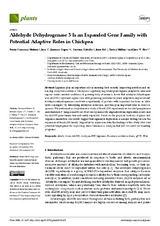Aldehyde Dehydrogenase 3 Is an Expanded Gene Family with Potential Adaptive Roles in Chickpea
Autor
Carmona Molero, Rocío
Jiménez-López, José C.
Caballo Linares, Cristina
Gil, Juan
Millán, Teresa
Die, Jose V.
Editor
MDPIFecha
2021Materia
Abiotic stressALDH
Chickpea
EST
Legumes
Fusarium
Oxidative stress
qPCR
SRA
METS:
Mostrar el registro METSPREMIS:
Mostrar el registro PREMISMetadatos
Mostrar el registro completo del ítemResumen
Legumes play an important role in ensuring food security, improving nutrition and enhancing ecosystem resilience. Chickpea is a globally important grain legume adapted to semi-arid regions under rain-fed conditions. A growing body of research shows that aldehyde dehydrogenases (ALDHs) represent a gene class with promising potential for plant adaptation improvement. Aldehyde dehydrogenases constitute a superfamily of proteins with important functions as ‘aldehyde scavengers’ by detoxifying aldehydes molecules, and thus play important roles in stress responses. We performed a comprehensive study of the ALDH superfamily in the chickpea genome and identified 27 unique ALDH loci. Most chickpea ALDHs originated from duplication events and the ALDH3 gene family was noticeably expanded. Based on the physical locations of genes and sequence similarities, our results suggest that segmental duplication is a major driving force in the expansion of the ALDH family. Supported by expression data, the findings of this study offer new potential target genes for improving stress tolerance in chickpea that will be useful for breeding programs.

